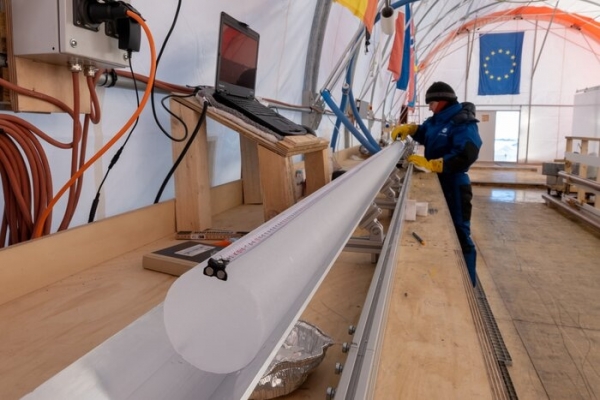Ice cores are a unique climate archive. Thanks to a new method developed by researchers at the University of Bern and Empa, greenhouse gas concentrations in 1.5 million year old ice can be measured even more accurately. The EU project “Beyond EPICA” with the participation of the University of Bern aims to recover such old ice in Antarctica.
The search for the oldest ice on earth has taken an important step forward. The Beyond EPICA – Oldest Ice project, a European consortium that includes the University of Bern, completed its second field season at the end of January. The drilling reached a depth of 808 meters. The project objective is to look back 1.5 million years into the past and obtain data on the development of temperature, the composition of the atmosphere and the carbon cycle. A depth of around 2700 meters must be reached in the Antarctic ice sheet and an ice core recovered. If everything goes as planned, this should be the case in 2025. Only then will the complex analysis of the oldest ice in this core follow, which new methods are currently being developed for.
The University of Bern plays a crucial role in the development of the new analysis technologies. The team led by Hubertus Fischer, professor of experimental climate physics and member of the Oeschger Center for Climate Change Research has succeeded, in collaboration with Empa, in developing a new technique to jointly measure the greenhouse gases carbon dioxide (CO2), methane (CH4) and nitrous oxide (N2O) as well as the carbon isotope composition of CO2. The ice sample needed for this is with a thickness of just one centimeter very small, yet the highest accuracy is possible in the measurement. “These are important prerequisites,” explains Hubertus Fischer, “for obtaining high-precision, high-resolution records from the oldest ice in Beyond EPICA.” In the 1.5 million year old ice, 15,000 to 20,000 years of climate history are compressed into just one meter of ice core, which places completely new demands on ice core analyzes. Ice cores are an extremely important climate archive because only they contain the air of the past to directly measure past greenhouse gas concentrations.
Read more at University of Bern
Image: A freshly drilled ice core is measured. (Credit: © PNRA/IPEV)


